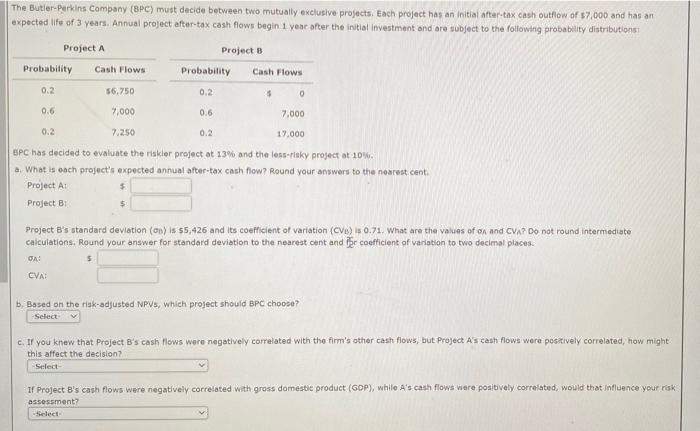Answered step by step
Verified Expert Solution
Question
1 Approved Answer
The Butler-Perkins Company (BPC) must decide between two mutually exclusive projects. Each project has an initial after-tax cash outflow of $7,000 and has an

The Butler-Perkins Company (BPC) must decide between two mutually exclusive projects. Each project has an initial after-tax cash outflow of $7,000 and has an expected life of 3 years. Annual project after-tax cash flows begin 1 year after the initial investment and are subject to the following probability distributions: Project A Probability Project B Cash Flows Probability Cash Flows 0.2 $6,750 0.2 $ 0 0.6 7,000 0.6 7,000 0.2 7.250 0.2 17.000 BPC has decided to evaluate the riskier project at 13% and the less-risky project at 10%. a. What is each project's expected annual after-tax cash flow? Round your answers to the nearest cent Project A: Project B: $ $ Project B's standard deviation (on) is $5,426 and its coefficient of variation (CVS) is 0.71. What are the values of OA and CVA? Do not round intermediate calculations. Round your answer for standard deviation to the nearest cent and r coefficient of variation to two decimal places. GA: CVA: $ b. Based on the risk-adjusted NPVs, which project should BPC choose? -Select- c. If you knew that Project B's cash flows were negatively correlated with the firm's other cash flows, but Project A's cash flows were positively correlated, how might this affect the decision? Select If Project B's cash flows were negatively correlated with gross domestic product (GDP), while A's cash flows were positively correlated, would that influence your risk assessment? -Select- The Butler-Perkins Company (BPC) must decide between two mutually exclusive projects. Each project has an initial after-tax cash outflow of $7,000 and has an expected life of 3 years. Annual project after-tax cash flows begin 1 year after the initial investment and are subject to the following probability distributions: Project A Probability Project B Cash Flows Probability Cash Flows 0.2 $6,750 0.2 $ 0 0.6 7,000 0.6 7,000 0.2 7.250 0.2 17.000 BPC has decided to evaluate the riskier project at 13% and the less-risky project at 10%. a. What is each project's expected annual after-tax cash flow? Round your answers to the nearest cent Project A: Project B: $ $ Project B's standard deviation (on) is $5,426 and its coefficient of variation (CVS) is 0.71. What are the values of OA and CVA? Do not round intermediate calculations. Round your answer for standard deviation to the nearest cent and r coefficient of variation to two decimal places. GA: CVA: $ b. Based on the risk-adjusted NPVs, which project should BPC choose? -Select- c. If you knew that Project B's cash flows were negatively correlated with the firm's other cash flows, but Project A's cash flows were positively correlated, how might this affect the decision? Select If Project B's cash flows were negatively correlated with gross domestic product (GDP), while A's cash flows were positively correlated, would that influence your risk assessment? -Select-
Step by Step Solution
There are 3 Steps involved in it
Step: 1
a To calculate each projects expected annual aftertax cash flow we need to multiply the cash flows by their respective probabilities and sum them up F...
Get Instant Access to Expert-Tailored Solutions
See step-by-step solutions with expert insights and AI powered tools for academic success
Step: 2

Step: 3

Ace Your Homework with AI
Get the answers you need in no time with our AI-driven, step-by-step assistance
Get Started


